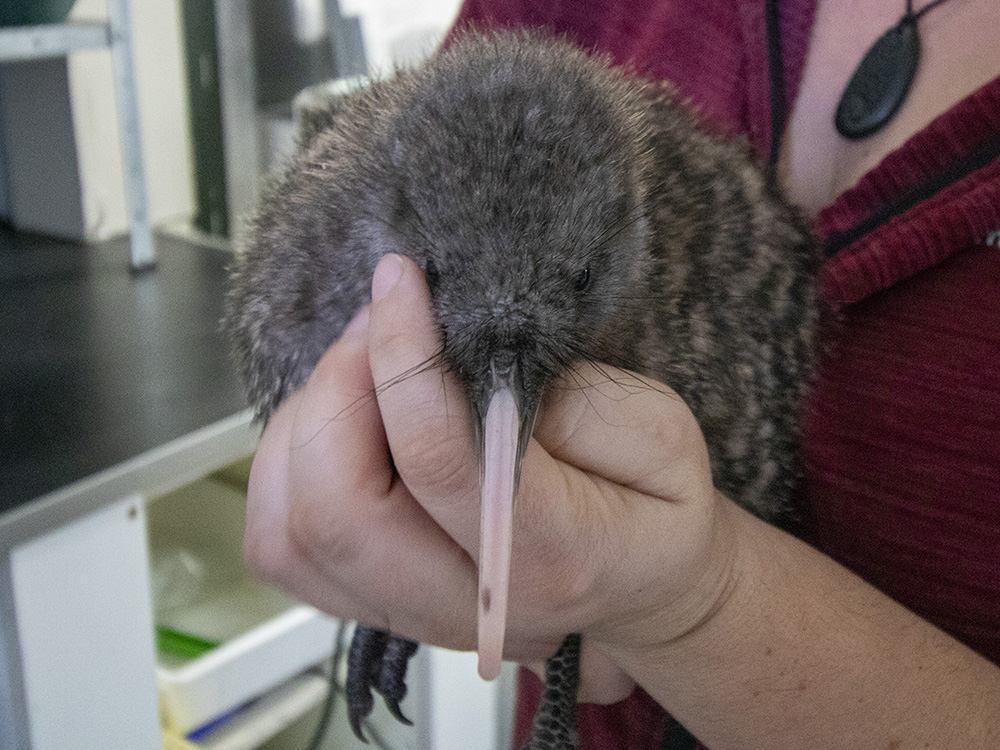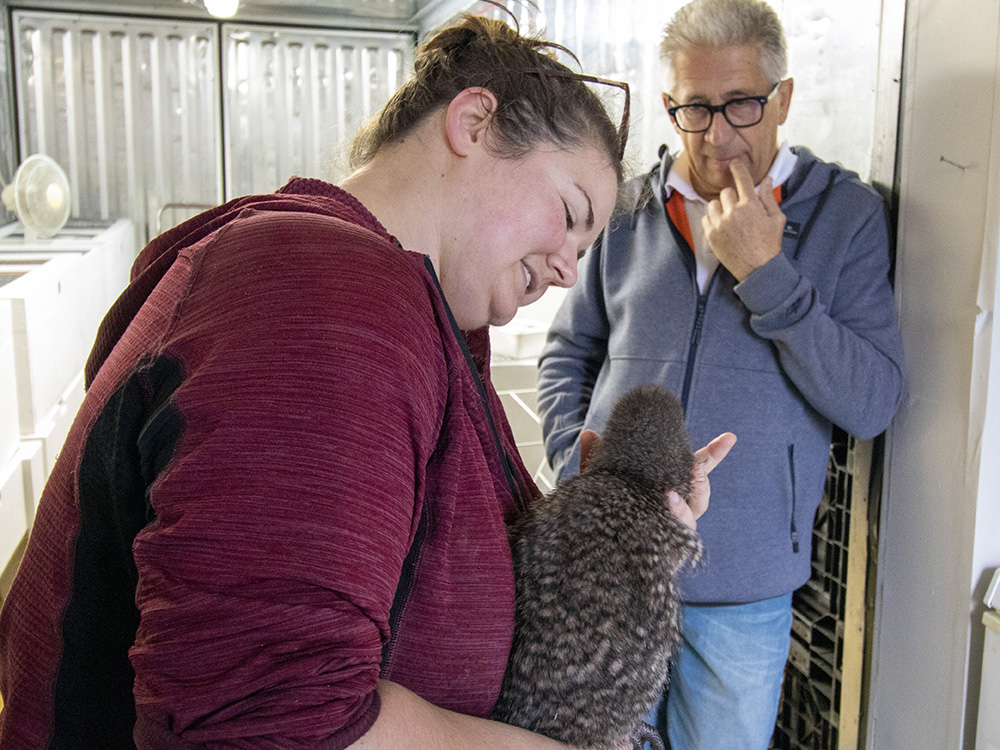New addition to Atarau Sanctuary
Meet the newest addition to the Verum Group-sponsored Atarau Wildlife Sanctuary. On 19 April, Verum Group Director Luc Bohyn took delivery of very precious cargo – a great spotted kiwi/ roroa chick hatched at the Willowbank Wildlife Reserve.
Willowbank Wildlife Kiwi Team Keeper Bethany Brett gives the great spotted kiwi chick a final check before it is crated for its journey to Atarau. Photo: Louise Thomas.

April 2023: Meet the newest addition to the Verum Group-sponsored Atarau Wildlife Sanctuary. On 19 April, Verum Group Director Luc Bohyn took delivery of very precious cargo – a great spotted kiwi/ roroa chick hatched at the Willowbank Wildlife Reserve.
Willowbank Wildlife Kiwi Team Keeper Bethany Brett and Luc gave the provisionally-named Xanthe a final weigh to make sure it had gained weight before carefully crating the chick for its journey across the Southern Alps to join other great spotted kiwi youngsters at Atarau. Kiwi chicks initially lose weight after they hatch as they use up the yolk sac contents over the first week or so before they start eating.

Held by Kiwi Keeper Bethany Brett, Xanthe the great spotted kiwi and Verum Group Director Luc Bohyn give each other the eye while contemplating travelling together. Photo: Louise Thomas.
Atarau Sanctuary provides a predator-free fully-fenced sanctuary for roroa raised through Paparoa Wildlife Trust’s Operation Nest Egg Program. Chicks are hatched at Willowbank Wildlife Reserve and then live in the sanctuary until they are old enough to fend for themselves out in the ranges. Xanthe was released into a special monitored crèche area, filled with thick native trees to keep it safe from the prying eyes of swamp harriers, until it is big enough to join the other youngsters who have free-reign of the 13ha sanctuary.
Verum Group scientists study the kiwi, both in the sanctuary and in the neighbouring Paparoa Ranges, as they work to refine acoustic monitoring techniques for various bird species.
Read the latest research on kiwi involving Verum Group scientists
Jahn, P., Ross, J.G., Mander, V. & Molles, L.E. (2022). Post-translocation movements and ranging behaviour of roroa (great spotted kiwi, Apteryx maxima). Notornis 69, 3, 135-146.
What it's about:
Translocations are increasingly used in kiwi (Apteryx spp.) conservation management, and their outcome is largely influenced by post-release dispersal and survival. A translocation of roroa (great spotted kiwi, A. maxima) to the Nina Valley, near Lake Summer Forest Park, is the first reintroduction of the Arthur’s Pass roroa population.
Jahn, P., Ross, J., MacKenzie, D. & Molles, L. (2022). Acoustic monitoring and occupancy analysis: cost-effective tools in reintroduction programmes for roroa-great spotted kiwi. New Zealand Journal of Ecology 46, 1, 3466. doi:10.20417/nzjecol.46.21
What it's about:
Monitoring the response of wildlife populations to conservation management, such as translocations, is crucially important for assessing its effectiveness. Passive acoustic monitoring (PAM) is an emerging tool for monitoring cryptic and elusive species and is increasingly used in the management of kiwi.
Bedoya, C. & Molles, L. (2021). Acoustic censusing and individual identification of birds in the wild. 14pgs. Preprint doi:10.1101/2021.10.29.466450
What it's about:
Individual bird calls carry information that can be utilized as an alternative to physical tagging of individuals. However, it is rarely used in conservation tasks despite rapidly-expanding use of passive acoustic monitoring techniques. Reliable acoustic individual recognizers and accurate quantifiers of population size remain elusive, which discourages the use of vocal individuality for monitoring, wildlife management, and ecological research. We propose a neuro-fuzzy framework that allows discrimination of individuals by their calls, the discovery of unexpected individuals in a set of recordings, and estimation of population size using solely sound.
Click here for Supplementary Information (Data) used in this paper.